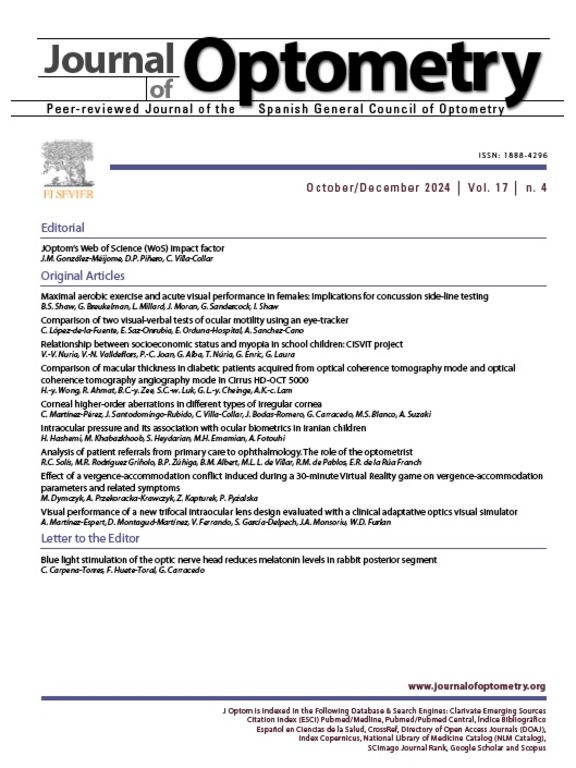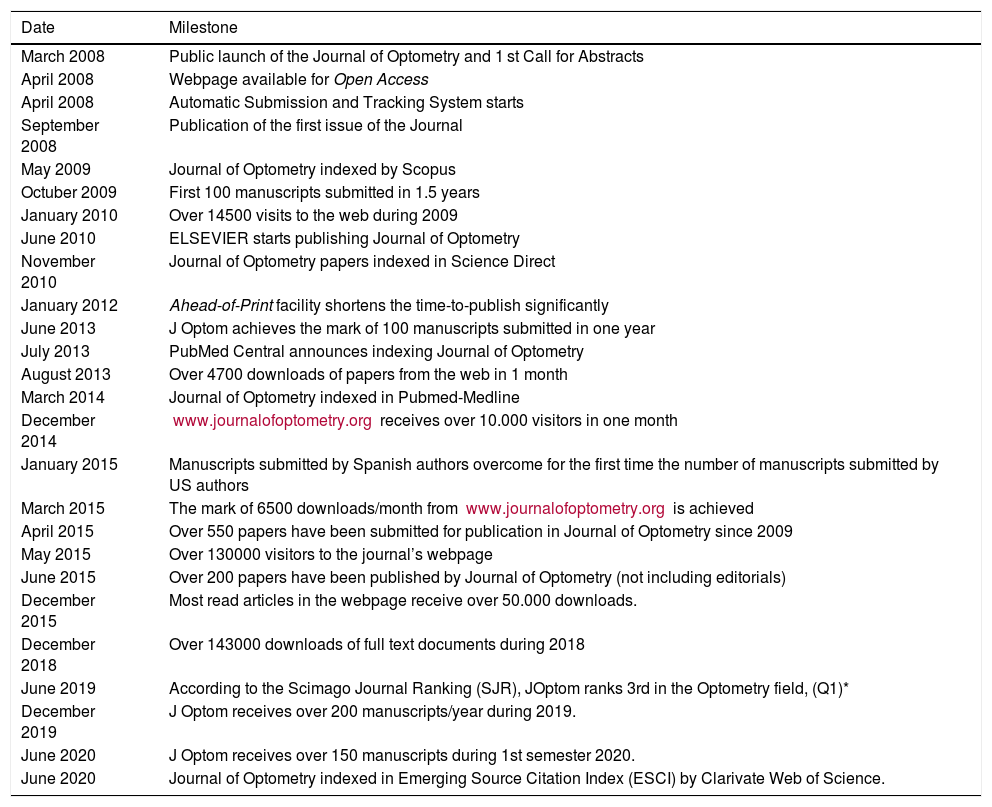By March 2020, while the entire planet Earth was entering a dark time of pandemia, we communicated in this editorial the trends of J Optom in different bibliometric indices including Impact Factor, SCImago Journal Ranking, H-index, CiteScore and Source Normalized Impact per Paper.1
More recently the CiteScore has been reviewed by Elsevier to mitigate some short-term trends and J Optom raised even further in its score from 1.65 to 2.3.2 According to Scoups, this new calculation enforces credibility of the score by only considering peer-review publications, considering a longer window of 4 years instead of 3 and considering the more recent citations in the year of calculation.3 This is only an aspect of the impact of the journal that has increased steadily as it continues to consolidate through different milestones achieved over the last years.4
Now, we received the communication that the Journal of Optometry has been included in the Emerging Sources Citation Index (ESCI) by Clarivate Web of Science. ESCI™ was introduced in 2015 and is part of the Web of Science Core Collection™, formerly known as Institute for Science Information Web of Science (ISI WoS) ranking. In the words of Clarivate Web of Science “ESCI contains quality publications, selected by our expert in-house editors for editorial rigor and best practice at a journal level”.5 This is an additional recognition for this project that joins to other previous achievements as the indexation in Pubmed and Pubmed Central among others,6 as illustrated in Fig. 1 and detailed in Table 1.
Some major landmarks achieved by Journal of Optometry.
| Date | Milestone |
|---|---|
| March 2008 | Public launch of the Journal of Optometry and 1 st Call for Abstracts |
| April 2008 | Webpage available for Open Access |
| April 2008 | Automatic Submission and Tracking System starts |
| September 2008 | Publication of the first issue of the Journal |
| May 2009 | Journal of Optometry indexed by Scopus |
| Octuber 2009 | First 100 manuscripts submitted in 1.5 years |
| January 2010 | Over 14500 visits to the web during 2009 |
| June 2010 | ELSEVIER starts publishing Journal of Optometry |
| November 2010 | Journal of Optometry papers indexed in Science Direct |
| January 2012 | Ahead-of-Print facility shortens the time-to-publish significantly |
| June 2013 | J Optom achieves the mark of 100 manuscripts submitted in one year |
| July 2013 | PubMed Central announces indexing Journal of Optometry |
| August 2013 | Over 4700 downloads of papers from the web in 1 month |
| March 2014 | Journal of Optometry indexed in Pubmed-Medline |
| December 2014 | www.journalofoptometry.org receives over 10.000 visitors in one month |
| January 2015 | Manuscripts submitted by Spanish authors overcome for the first time the number of manuscripts submitted by US authors |
| March 2015 | The mark of 6500 downloads/month from www.journalofoptometry.org is achieved |
| April 2015 | Over 550 papers have been submitted for publication in Journal of Optometry since 2009 |
| May 2015 | Over 130000 visitors to the journal’s webpage |
| June 2015 | Over 200 papers have been published by Journal of Optometry (not including editorials) |
| December 2015 | Most read articles in the webpage receive over 50.000 downloads. |
| December 2018 | Over 143000 downloads of full text documents during 2018 |
| June 2019 | According to the Scimago Journal Ranking (SJR), JOptom ranks 3rd in the Optometry field, (Q1)* |
| December 2019 | J Optom receives over 200 manuscripts/year during 2019. |
| June 2020 | J Optom receives over 150 manuscripts during 1st semester 2020. |
| June 2020 | Journal of Optometry indexed in Emerging Source Citation Index (ESCI) by Clarivate Web of Science. |
Going back to the new calculation algorith of CiteScore, it is very important that the updated score for Journal of Optometry as well as for most of the optometric oriented journals raised, meaning that the citation profile is currently increasing in this field and those citations are originated from peer-review publications. Journal of Optometry commits with this principle that oriented our strategy from the early times of the journal to warrant peer-review process to all the material being published as Reviews and Meta-analysis, Original Articles, Case Reports and Technical Letters. This has been the practice even for COVID-19 related publications submitted to J Optom over the last months, including some of them already published as “pre-proof” or “corrected proof” after going through peer-review, instead of “pre-print” before peer-review process.7–9 With that approach J Optom remains faithful to scientific values, avoiding to contribute to fast, “non-filtered” information overload,10 including pre-print publication that has been recently under strong scrutiny,11,12 including several retractions of published manuscript.13Fig. 2A shows the weekly evolution of publications indexed in Pubmed from January through May 2020 fitted to a “pandemic” progression exponential trend similar to the one followed in many countries by the reported new COVID-19 cases during the first wave (Fig. 2B).
(A): Weekly evolution of publications in Pubmed retrieved with keywords “covid-19” during the 21 weeks after reaching ≥100 publications showing duplication of the number of publications every 3.3 weeks (Theor.). Search for cumulative publications in: https://pubmed.ncbi.nlm.nih.gov/ from January 2019 for (covid-19) AND "(2019/01/30"[Date - Publication]: "2020/moth/day"[Date - Publication]) till July 29th, 2020 when the search was updated. (B): Evolution of new cases during Covid-19 pandemic in several countries during first 21 days adjusted to Day 1 when ≥1case/million was achieved. China data arbitrarily fitted to a population of 125 million.
CH: China; IT: Italy; ES: Spain; PT: Portugal; DE: Germany; US: United States of America; Theor: theoretical fitting assumes that new cases duplicate approximately every 3.3 days or an increase of 30% every day.
Of course, the role of pre-print publication in such an emergency should not be dismissed, but demands even more critical thinking9 from the audience of those journals to appraise the information published before making decisions with impact on people’s lifes.14,15 Social media journalists should also be aware of the characteristics of the different publications and the impact of the reviewing process when they communicate to their audience as such information might have impact on individuals and policy making un emergency situations as the recent pandemic remind us.16






![(A): Weekly evolution of publications in Pubmed retrieved with keywords “covid-19” during the 21 weeks after reaching ≥100 publications showing duplication of the number of publications every 3.3 weeks (Theor.). Search for cumulative publications in: https://pubmed.ncbi.nlm.nih.gov/ from January 2019 for (covid-19) AND "(2019/01/30"[Date - Publication]: "2020/moth/day"[Date - Publication]) till July 29th, 2020 when the search was updated. (B): Evolution of new cases during Covid-19 pandemic in several countries during first 21 days adjusted to Day 1 when ≥1case/million was achieved. China data arbitrarily fitted to a population of 125 million. CH: China; IT: Italy; ES: Spain; PT: Portugal; DE: Germany; US: United States of America; Theor: theoretical fitting assumes that new cases duplicate approximately every 3.3 days or an increase of 30% every day. (A): Weekly evolution of publications in Pubmed retrieved with keywords “covid-19” during the 21 weeks after reaching ≥100 publications showing duplication of the number of publications every 3.3 weeks (Theor.). Search for cumulative publications in: https://pubmed.ncbi.nlm.nih.gov/ from January 2019 for (covid-19) AND "(2019/01/30"[Date - Publication]: "2020/moth/day"[Date - Publication]) till July 29th, 2020 when the search was updated. (B): Evolution of new cases during Covid-19 pandemic in several countries during first 21 days adjusted to Day 1 when ≥1case/million was achieved. China data arbitrarily fitted to a population of 125 million. CH: China; IT: Italy; ES: Spain; PT: Portugal; DE: Germany; US: United States of America; Theor: theoretical fitting assumes that new cases duplicate approximately every 3.3 days or an increase of 30% every day.](https://static.elsevier.es/multimedia/18884296/0000001300000004/v1_202009270621/S1888429620300698/v1_202009270621/en/main.assets/thumbnail/gr2.jpeg?xkr=ue/ImdikoIMrsJoerZ+w90elkTtpMHXMkN9jatH7+0Y=)





